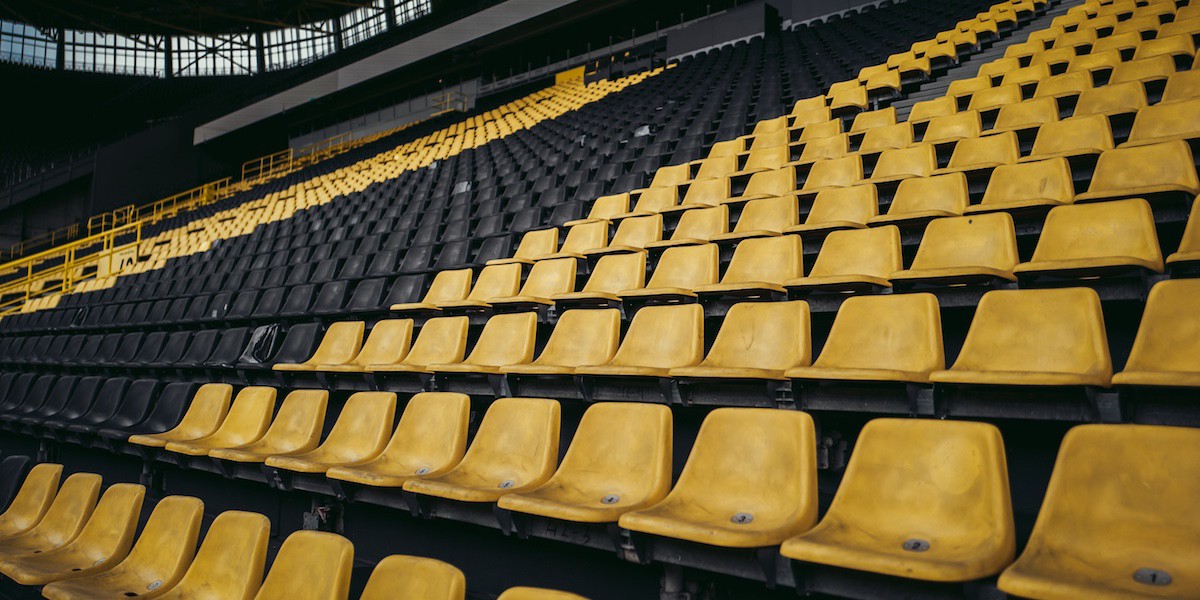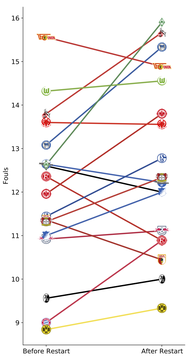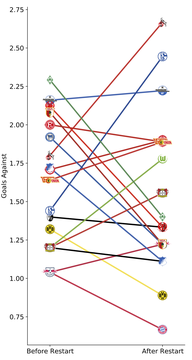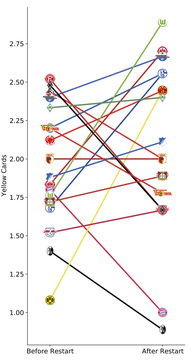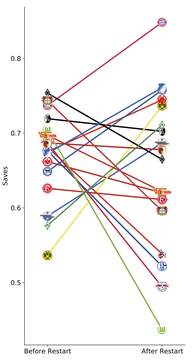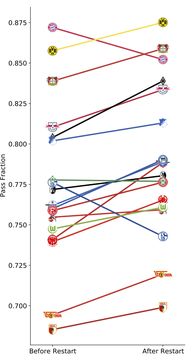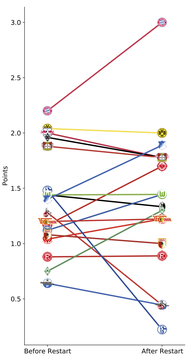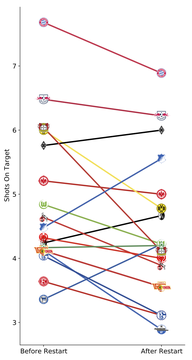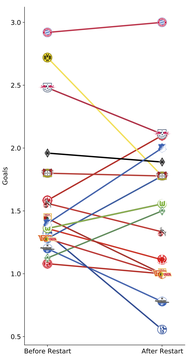In the first half of 2020 the new Corona virus, which causes the lung disease Covid-19, presented humanity with a great challenge. To prevent the virus from spreading in many countries public life was severely restricted, quarantine was imposed, social contacts were limited, whole areas were completely isolated from the outside world.
For most people their daily life changed drastically during that period. In some countries there were large-scale dismissals. People had to wear masks in public. Parts of economy collapsed or got weaken to great extent. In public and in offices people had to respect minimum distances. One professional group, becoming a focus of media interest as of late, is affected in a complete different way: professional soccer players. There was much discussion about violation of minimum distances in contact sport, about test capacities which would be needed and about the signal sent if the game activity would be restarted.

Some clubs were on the verge of bankruptcy, furthermore, soccer was seen as a kind of positive distraction and sort of a silver lining. Thus, professional sport was resumed under strict rules in some European soccer associations. The German Bundesliga was the first professional league to restart after the Corona-break. The bigest difference from before: there were fans allowed in the stadiums.
Now, the question is: How did the the break, the German Bundesliga was paused between March 11th and May 16th, and the absent crowds affect the game?
A Quarter of All Season Matches Behind Closed Doors
In the following we compare several performance statistics of German Bundesliga clubs from before and after the Corona-restart. The period with matches behind closed doors accounts for one quarter of the season. During this time, empty stadiums make interesting insights in the communication on the soccer pitch possible. There are particularly vocal teams which constantly communicate within the players and between the stuff and players and there are clubs which rarely give instructions to each other. And there is Werder Bremen, where substitute players or stuff members hit metal boxes with rubber mallets to make the greatest possible noise [1]. Maybe it worked: after the restart, Werder Bremen scored more goals and conceded less goals than before, c.f. below.
Home-field Advantage Disappears
First let us take a look at league-wide statistics. The most important finding: home teams have no advantage anymore, it is quite the contrary. Before the restart, home teams won 43% of the matches, 22% resulted in a draw, only 35% of the matches were won by the away team.
Since the restart these ratios are inverted, now away teams get 12.5% more points because they win 45% of the matches. After the restart, 23% of the games resulted in a draw, the remaining 32% were won by the home team. It is remarkable that both the home team and the away team are affected in the number of scored goals. The away teams score more goals during matches behind closed doors, away teams score less.
The number of shots on target is decreasing, however, this diagram does not differentiate between home team and away team. A more detailed analysis shows that home teams shot 16% less on the goal of the opponent. Concerning away teams it can be seen that there is only a decrease of 6%, therefore, away teams are on the same level as home teams regarding absolute numbers. Correspondingly, away teams seem to perform more efficient. Whether this is due to a larger number of easy to use great scoring opportunities or due to trying from better scoring positions in general can not be explained. For this purpose the defensive performance has to be analyzed.
FC Schalke 04 and 1.FC Cologne are the Big Losers, Werder Bremen and 1899 Hoffenheim Benefit
The team of FC Schalke 04 is the biggest loser after the restart. Actually the complete second half of the season of Schalke was extremely bad, however, the matches after the restart were striking. Just 2 points were scored in the remaining nine games. Lets look at several stats and how Schalke (and 1. FC Cologne) performed in contrast to other German Bundesliga clubs.
Before the Corona-break Schalke were 6th on the league table.
Concerning pass accuracy, fraction of saves and goals conceded they ranked in midfield of the Bundesliga clubs.
 The opportunity-to-goal ratio was not bad, however, Schalke had not many opportunities (i.e. shots on target) after all.
Nonetheless they managed score a decent amount of points, hence, they could be classified as an overachiever.
But, again, the extremely bad second half of the season comes into play.
Between the winter break and Corona-break they already just scored 4 points.
Thus, their decline started earlier than the time Corona hit the world.
Nonetheless, Schalkes performance after the restart were spectacularly bad, in all statistics presented they are one of the three worst teams.
The passing accuracy got way worse, which could be attributed to the decreasing self-confidence of the players.
Percentagewise more opposing shots on target could not be saved by the goalkeeper which let to more goals conceded.
Another interesting aspect is the offensive side of the ball.
As it was the case before the restart, Schalke could not manage to score goals from their limited opportunities.
They had no luck, they lost their coolness, they had not created great opportunities anymore.
1. FC Cologne showed a way worse performance after the restart also, though the played solid season before the Corona-break.
In their case, they had their fair share of problems with to many goals conceded during the last 9 games of the season, most by all German Bundesliga clubs.
Especially the 6:1 loss against Bremen stands out. Bremen managed to qualify for the relegation match that way.
The opportunity-to-goal ratio was not bad, however, Schalke had not many opportunities (i.e. shots on target) after all.
Nonetheless they managed score a decent amount of points, hence, they could be classified as an overachiever.
But, again, the extremely bad second half of the season comes into play.
Between the winter break and Corona-break they already just scored 4 points.
Thus, their decline started earlier than the time Corona hit the world.
Nonetheless, Schalkes performance after the restart were spectacularly bad, in all statistics presented they are one of the three worst teams.
The passing accuracy got way worse, which could be attributed to the decreasing self-confidence of the players.
Percentagewise more opposing shots on target could not be saved by the goalkeeper which let to more goals conceded.
Another interesting aspect is the offensive side of the ball.
As it was the case before the restart, Schalke could not manage to score goals from their limited opportunities.
They had no luck, they lost their coolness, they had not created great opportunities anymore.
1. FC Cologne showed a way worse performance after the restart also, though the played solid season before the Corona-break.
In their case, they had their fair share of problems with to many goals conceded during the last 9 games of the season, most by all German Bundesliga clubs.
Especially the 6:1 loss against Bremen stands out. Bremen managed to qualify for the relegation match that way.
Looking at the performance of Werder Bremen before and after the restart, we can see a completely different picture. An obvious better performance in almost all aspects could be observed. However, in general, Bremen played a very disappointing season. Although they aimed to qualify for international contests, however, Bremen did not show the targeted performance and could not reach the success that was assumed before the season. That Bremen has more talent in their ranks than their place on the final table lets you think can be assumed because of their passing accuracy. However, their defense was the worst in the league before the Corona-break, neither their back line nor their goalkeeper (c.f. fraction of saved shots) could not convince. During the break, Bremen transformed to reasonably solid Bundesliga club with a good goaltender between the goalpost [2]. Needless to say, that you have to keep the 6:1 blowout win in mind during the last match day, though this game is part of the season as every other game is (like the 6:1-loss against Bayern Munich which was followed by a 5:0-loss against Mainz). A similar transformation was experienced by 1899 Hoffenheim, though in different regions of the table. Before the restart they assumed a midfield spot on the table, but the evolved to top 3 team of the German Bundesliga. They managed to finish in 6th place and therefore play in international contests next season.

Slight Increasing Number of Fouls, Change in the Amount of Yellow Cards
At the beginning of this section I want to stress that the causes of observations described below can not be deduced from the data itself. We can only assume various causes. Nonetheless, this is an interesting observation which should be mentioned Bremen established a harder line after the restart, however, the number of yellow cards stayed at the same level, albeit a high level. In general, after the Corona-break, one can see that two third of the clubs committed more fouls on average and the number of yellow cards increased. This can be due to several reasons. It is possible that the referees changed their way of officiating slightly. Alternatively, the break could have let to harder play by the players. Or the break caused that the players were a little bit late to tackle more often and hence committed a foul. Another possibility could be that the increase is due to the lack of fans in attendance. This way the players can be heard better as well as potential cries of pain, on the other hand the referee is not affected or distracted by the reaction of the crowd.
Gallery containing various stats and their mean values
In the gallery below you can find all important KPIs with their mean values from before and after the Corona-break. Namely, the number of goals, the number of goals conceded, points, fouls, yellow cards, number of shots on target and the fraction of saves from the goalkeeper. Pictured are all German Bundesliga clubs from this season.
The Corona-break and Matches Behind Closed Doors Changed the German Bundesliga
After the restart the German Bundesliga changed. Home-field advantage dwindled away, there were less goalscoring opportunities and a safer and calmer style of football was played. Whether this was due to the missing crowds or due to the long break is not possible to brake down with this analysis. However, home teams always did worse in matches behind closed doors than with fans in attendance [3]. To get to the bottom of this question, we have to compare the beginning of the season with the end of the season. This will be done in a following article. You can read about the technical background in the corresponding Project.
‘In football, the worst blindness is only seeing the ball’ - Nelson Falcão Rodrigues
References
[1] https://www.weser-kurier.de/werder/werder-bundesliga_artikel,-der-hammertyp-von-der-werderbank-_arid,1917232.html
[2] https://www.kicker.de/pavlenka-jiri-85936/spieler
[3] https://www.rbb24.de/sport/thema/2020/coronavirus/beitraege_neu/2020/06/fussball-bundesliga-so-anders-sind-geisterspiele.html
